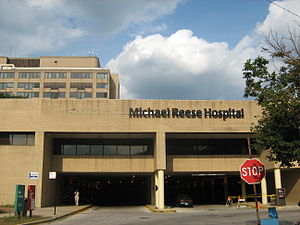
Walter Adolph Georg Gropius was a German-American architect and founder of the Bauhaus School, who, along with Alvar Aalto, Ludwig Mies van der Rohe, Le Corbusier and Frank Lloyd Wright, is widely regarded as one of the pioneering masters of modernist architecture. He is a founder of Bauhaus in Weimar (1919). Gropius was also a leading architect of the International Style.
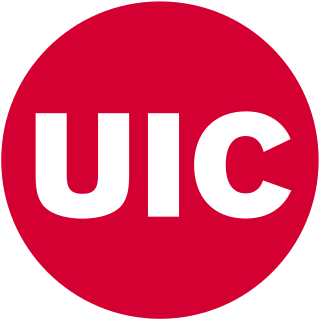
The University of Illinois Chicago (UIC) is a public research university in Chicago, Illinois, United States. Its campus is in the Near West Side community area, adjacent to the Chicago Loop. The second campus established under the University of Illinois system, UIC is also the largest university in the Chicago metropolitan area, having more than 33,000 students enrolled in 16 colleges. It is classified among "R1: Doctoral Universities – Very high research activity."
Humana Inc. is a for-profit American health insurance company based in Louisville, Kentucky. In 2023, the company ranked 42 on the Fortune 500 list, which made it the highest ranked company based in Kentucky. It is the fourth largest health insurance provider in the U.S.

HCA Healthcare is an American for-profit operator of health care facilities that was founded in 1968. It is based in Nashville, Tennessee, and, as of May 2020, owns and operates 186 hospitals and approximately 2,000 sites of care, including surgery centers, freestanding emergency rooms, urgent care centers and physician clinics in 21 states and the United Kingdom. As of 2023, HCA Healthcare is ranked #66 on the Fortune 500 rankings of the largest United States corporations by total revenue.

The University of Texas MD Anderson Cancer Center is a comprehensive cancer center in Houston, Texas. It is the largest cancer center in the U.S. and one of the original three comprehensive cancer centers in the country. It is both a degree-granting academic institution and a cancer treatment and research center located at the Texas Medical Center in Houston. It is affiliated with The University of Texas Health Science Center at Houston. According to Newsweek, MD Anderson Cancer Center is considered the best hospital in the world for oncology and related cancer treatment.

Douglas, on the South Side of Chicago, Illinois, is one of Chicago's 77 community areas. The neighborhood is named for Stephen A. Douglas, Illinois politician and Abraham Lincoln's political foe, whose estate included a tract of land given to the federal government. This tract later was developed for use as the Civil War Union training and prison camp, Camp Douglas, located in what is now the eastern portion of the Douglas neighborhood. Douglas gave that part of his estate at Cottage Grove and 35th to the Old University of Chicago. The Chicago 2016 Olympic bid planned for the Olympic Village to be constructed on a 37-acre (15 ha) truck parking lot, south of McCormick Place, that is mostly in the Douglas community area and partly in the Near South Side.

The Danvers State Hospital, also known as the State Lunatic Hospital at Danvers, The Danvers Lunatic Asylum, and The Danvers State Insane Asylum, was a psychiatric hospital located in Danvers, Massachusetts. It was built in 1874, and opened in 1878, under the supervision of prominent Boston architect Nathaniel Jeremiah Bradlee, on an isolated site in rural Massachusetts. It was a multi-acre, self-contained psychiatric hospital designed and built according to the Kirkbride Plan.
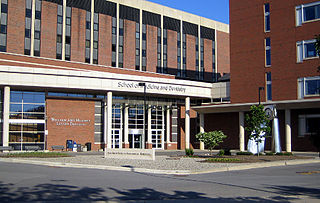
The University of Rochester Medical Center (URMC), now known as UR Medicine, is located in Rochester, New York, is one of the main campuses of the University of Rochester and comprises the university's primary medical education, research and patient care facilities.

Tenet Healthcare Corporation is a for-profit multinational healthcare services company based in Dallas, Texas, United States. Through its brands, subsidiaries, joint ventures, and partnerships, including United Surgical Partners International (USPI), the company operates 65 hospitals and over 450 healthcare facilities. Tenet also operates Conifer Health Solutions, which provides healthcare support services to health systems and other clients.

The University of Chicago Medical Center is a nationally ranked academic medical center located in Hyde Park on the South Side of Chicago. It is the flagship campus for The University of Chicago Medicine system and was established in 1898. Affiliated with and located on The University of Chicago campus, it also serves as the teaching hospital for Pritzker School of Medicine. Primary medical facilities on campus include the Center for Care and Discovery, Bernard A. Mitchell Hospital, and Comer Children's Hospital.

The Chicago bid for the 2016 Summer Olympics and Paralympics was an unsuccessful bid, first recognized by the International Olympic Committee (IOC) on September 14, 2007. The IOC shortlisted four of the seven applicant cities—Madrid, Spain; Tokyo, Japan; Rio de Janeiro, Brazil; and Chicago, United States; over Baku, Azerbaijan; Doha, Qatar; and Prague, Czech Republic—on June 4, 2008, during a meeting in Athens, Greece. This was followed by an intensive bidding process which finished with the election of Rio de Janeiro at the 121st IOC Session in Copenhagen, Denmark, on October 2, 2009.
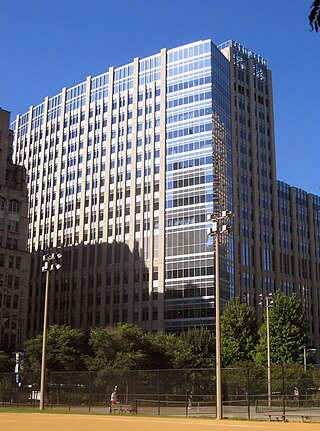
Northwestern Memorial Hospital (NMH) is a nationally ranked academic medical center located on Northwestern University's Chicago campus in Streeterville, Chicago, Illinois. It is the flagship campus for Northwestern Medicine and the primary teaching hospital for the Feinberg School of Medicine at Northwestern University. Affiliated institutions also located on campus include the Ann & Robert H. Lurie Children's Hospital with Level I pediatric trauma care and the Shirley Ryan AbilityLab, a leader in physical medicine and rehabilitation.

Mercy Hospital and Medical Center now called Insight Hospital and Medical Center Chicago is a 414-bed general medical and surgical Catholic teaching hospital in Chicago, Illinois. Established in 1852, the hospital was the first chartered hospital in Chicago. In 1859, Mercy Hospital became the first Catholic hospital to affiliate with a medical school—Lind Medical School—and the first to require a graded curriculum.

Advocate Lutheran General Hospital (ALGH) is a 645-bed non-profit teaching hospital located in the Chicago suburb of Park Ridge, Illinois. Founded in 1897, Advocate Lutheran General Hospital is the sixth largest hospital in the Chicago area, and it operates a Level I trauma center. It also is home to Advocate Children's Hospital – Park Ridge, the only children's hospital in the greater north and northwest suburban region of Chicago. The hospital is a part of Advocate Aurora Health.
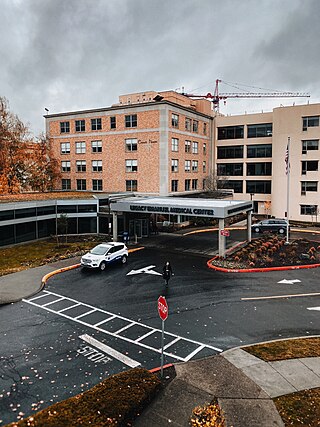
Legacy Emanuel Medical Center is a hospital located in the Eliot neighborhood of Portland, Oregon, United States. Founded in 1912, it is one of only two Level I trauma centers in the state of Oregon, and home to the only burn center between Seattle and Sacramento. The hospital is also home to the Life Flight Network (MEDEVAC), the first of its kind instituted on the U.S. West Coast. The 554-bed facility provides a full range of services, including conventional surgery, heart treatment, critical care, neurology/stroke care/brain surgery, and care for high-risk pregnancies. Legacy Emanuel also houses the Randall Children's Hospital. It is one of the hospitals in the area where gun shot victims are routinely brought in.
Mount Sinai Hospital, formerly at times known as Mount Sinai Medical Center, is a 319-bed major urban hospital in Chicago, Illinois, with its main campus located adjacent to Douglass Park at 15th Street and California Avenue on the city's West Side. The hospital was established in 1912 under the name Maimonides Hospital, with a mission of serving poor immigrants from Europe while providing training to Jewish physicians, primarily of Eastern European descent. After a period of financial difficulty, it closed in 1918, and was reopened as "Mount Sinai Hospital" in 1919, with 60 beds and continuing its original mission.
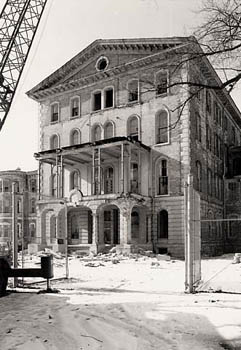
The Elgin Mental Health Center is a mental health facility operated by the State of Illinois in Elgin, Illinois. Throughout its history, Elgin's mission has changed. At times, it treated mental illness, tuberculosis, and provided federally funded care for veterans. The hospital's site, which included a patient-staffed farm reached a maximum of 1,139 acres (461 ha) after World War II. Its maximum population was reached in the mid 1950s with 7,700 patients. Between 1993 and 2008, most of the older buildings in the complex were demolished due to being in poor condition as the result of being abandoned for decades. The site is/was popular among teens and in the paranormal world due to its claims of hauntings in the older buildings and the hospital's cemetery.
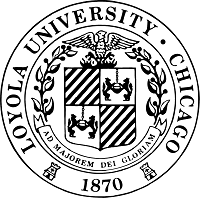
Loyola University Chicago is a private research university in Chicago, Illinois. Founded in 1870 by the Society of Jesus, Loyola is one of the largest Catholic universities in the United States. Its namesake is Saint Ignatius of Loyola. Loyola's professional schools include programs in medicine, nursing, and health sciences anchored by the Loyola University Medical Center. It is classified among "R2: Doctoral Universities – High research activity".

The Prentice Women's Hospital and Maternity Center was a hospital on the Downtown Chicago campus of Northwestern University's Northwestern Memorial Hospital in the Streeterville district of Chicago's Near North Side.

The Ohio State University Wexner Medical Center East Hospital is a university hospital in King-Lincoln Bronzeville, Columbus, Ohio. The hospital has a Level III trauma center, an emergency department, and provides numerous inpatient and outpatient services. It is part of the Wexner Medical Center, administered by the Ohio State University.
